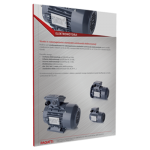ELECTRIC MOTORS
An electric motor is a machine that converts electrical energy into mechanical energy. In general, electric motors are divided into direct current (DC) motors and alternating current (AC) motors.
DC motors can further be categorized into brushed and brushless DC motors, while AC motors can be asynchronous (induction) or synchronous. Furthermore, these can be classified into motors with permanent magnets, stepper motors, and reluctance motors. Asynchronous (induction) motors are widely used in most electric drives today and are the most commonly used motors in the industry.
The primary advantage of asynchronous motors over brushed DC motors is the absence of a mechanical commutator, which significantly reduces cost and maintenance expenses.
Asynchronous motors also have a significantly higher efficiency compared to DC motors.
In asynchronous motors, the rotational speed of the rotor decreases with load. The rotor rotates slightly slower than the rotating magnetic field.
The difference between the rotor’s rotational speed and the magnetic field’s rotational speed is called “slip” and is usually expressed in percentages. These motors are capable of temporarily handling high overloads (approximately 3 times the rated mechanical load, and special designs can handle even more).
The company PAGATTI offers:
Low-voltage electric motors from 0.01 kW to 4800 kW, with sizes ranging from 45 to 710.
High-voltage electric motors up to 25 MW, with sizes up to 1700.
Special electric motors, made to order, ranging from 0.09 kW to 25 MW, with sizes from 80 to 1120.
- Standard industrial IEC motors
- Three-phase, single-phase, two-speed, and brake motors.
- Explosion-proof electric motors.
- Chemically resistant electric motors.
- Motors for mining applications.
- Custom electric motors made to customer specifications.
- Wide availability of stock.
- Short delivery times.
- Continuous technical and commercial support.

